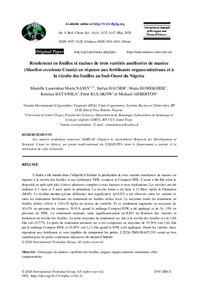| dc.contributor.author | Moita-Nassy, M. |
| dc.contributor.author | Hauser, S. |
| dc.contributor.author | Egwekhide, M. |
| dc.contributor.author | Batawila, K. |
| dc.contributor.author | Kulakow, P. |
| dc.contributor.author | Abberton, M. |
| dc.date.accessioned | 2022-08-25T13:40:11Z |
| dc.date.available | 2022-08-25T13:40:11Z |
| dc.date.issued | 2020-05 |
| dc.identifier.citation | Moita-Nassy, M., Hauser, S., Egwekhide, M., Batawila, K., Kulakow, P. & Abberton, M. (2020). Leaf and roots yields responses of three improved cassava (Manihot esculenta Crantz) varieties to organo-mineral fertilizers and leaf harvest in the South-West Nigeria. International Journal of Biological and Chemical Sciences, 14(4), 1432-1447. |
| dc.identifier.issn | 1997-342X |
| dc.identifier.uri | https://hdl.handle.net/20.500.12478/7693 |
| dc.description.abstract | L’étude a été menée dans l’objectif d’évaluer la production de trois variétés améliorées de manioc en réponse à la récolte des feuilles et aux fertilisants NPK, compost et Compost-NPK. L’essai a été fait selon le dispositif en split-split plot, à blocs aléatoires complets à trois facteurs et trois réplications. Les récoltes ont été réalisées à 3 mois et 5 mois après la plantation. La récolte finale a été faite à 12 Mois Après la Plantation (MAP). Le résultat montre qu’une différence non significative (p>0,05) a été observée entre les variétés et entre les traitements fertilisants du rendement en feuilles sèches total. La moyenne totale du rendement en feuilles sèches s'élève à 1454,19 kg/ha au niveau du contrôle. Et ce rendement augmente en moyenne de 10,42% en présence du compost, 39,91% quand le mélange Compost-NPK a été appliqué et de 34, 19% en présence de NPK. Le rendement racinaire varie significativement (p˂0,05) en fonction des variétés et traitement de récolte des feuilles. La perte moyenne de rendement sec due à la récolte des feuilles est de 3,86 t/ha soit 45,77%. La perte du rendement racinaire sec a été compensée en moyenne de 35,59% soit 1,64 t/ha par le mélange Compost-NPK, et 24,05% soit 1,11 t/ha quand le NPK a été appliquée. Parmi les variétés, deux répondent aux fertilisants et sont capables de compenser les pertes. L’IITA-TMS-IBA071393 serait un bon candidat pour les petits exploitants dépourvus de moyen d’intrant. This study was carried out to investigate the leaf and root yield response to leaf harvest and the application of NPK fertilizer, compost and the combination of NPK plus compost of three improved cassava varieties. The experiment was a complete randomised split-split plot design with three factors and three replications. Leaf harvest was at 3 months and 5 months after planting (MAP). The final root harvest was at 12 MAP. The leaf dry matter yield was not significantly (p> 0.05) different between varieties and fertilizer treatments. The average leaf yield was 1454.19 kg/ha DM in control. Leaf yield increased by 10.42% when compost was applied, by 39.91% when compost plus NPK was applied and by 34.19% when only NPK was applied. Root yield was significantly (p˂0.05) affected by cassava variety and leaf harvest. Average root DM yield losses were 3.86 t/ha (45.77%) when leaves were harvested. Root DM yield loss was compensated to 35.59% (1.64 t/ha) when compost plus NPK fertilizer was applied and 24.05% (1.11 t/ha) when NPK was applied. Two varieties responded positively to fertilisers and were able to compensate for root yield losses. IITA-TMS-IBA071393 appears a suitable candidate for cassava farmers with small income because it did not require inputs. |
| dc.format.extent | 1432-1447 |
| dc.language.iso | en |
| dc.subject | Cassava |
| dc.subject | Genotypes |
| dc.subject | Minerals |
| dc.subject | Yields |
| dc.subject | Compensation |
| dc.subject | Nigeria |
| dc.title | Rendement en feuilles et racines de trois variétés améliorées de manioc (Manihot esculenta Crantz) en réponse aux fertilisants organo-minéraux et à la récolte des feuilles au Sud-Ouest du Nigeria |
| dc.title.alternative | Leaf and roots yields responses of three improved cassava (Manihot esculenta Crantz) varieties to organo-mineral fertilizers and leaf harvest in the South-West Nigeria |
| dc.type | Journal Article |
| cg.contributor.crp | Genebanks |
| cg.contributor.crp | Roots, Tubers and Bananas |
| cg.contributor.affiliation | International Institute of Tropical Agriculture |
| cg.contributor.affiliation | Université de Lomé |
| cg.coverage.region | Africa |
| cg.coverage.region | West Africa |
| cg.coverage.country | Nigeria |
| cg.coverage.hub | Headquarters and Western Africa Hub |
| cg.researchtheme | Biotech and Plant Breeding |
| cg.identifier.bibtexciteid | MOITANASSY:2020 |
| cg.isijournal | ISI Journal |
| cg.authorship.types | CGIAR and developing country institute |
| cg.iitasubject | Agronomy |
| cg.iitasubject | Cassava |
| cg.iitasubject | Soil Fertility |
| cg.journal | International Journal of Biological and Chemical Sciences |
| cg.notes | Published online: May 2020 |
| cg.accessibilitystatus | Open Access |
| cg.reviewstatus | Peer Review |
| cg.usagerightslicense | Creative Commons Attribution 4.0 (CC BY 0.0) |
| cg.targetaudience | Scientists |
| cg.identifier.doi | https://dx.doi.org/10.4314/ijbcs.v14i4.21 |
| cg.iitaauthor.identifier | Stefan Hauser: 0000-0002-6329-7783 |
| cg.iitaauthor.identifier | Peter Kulakow: 0000-0002-7574-2645 |
| cg.iitaauthor.identifier | Michael Abberton: 0000-0003-2555-9591 |
| cg.futureupdate.required | No |
| cg.identifier.issue | 4 |
| cg.identifier.volume | 14 |

